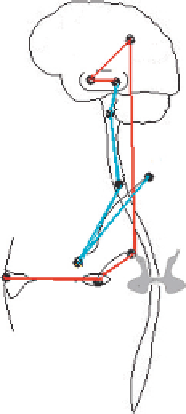Biology Reference
In-Depth Information
1 Cold thermoreceptors
2 Dorsal root ganglion
3 Dorsal horn
4 GABAergic neurons
5 POA neurons
6 DMH neurons
7 Sympathetic premotor neurons in
rostral raphe pallidus in brain
8 IML autonomic motor neurons
9 Postganglionic sympathetic nerves
10 Adipocyte
4
5
6
7
10
8
Postganglionic
nerve ending
3
NE
9
1
β
-AR
2
UCP-1
MT
Figure 4.1
The simplified neural circuit for processing the cold temperature signal
transmitted by cold thermosensory nerve endings. Numbers in the figure show the sequential
steps of processing the stimulus in the nervous system. The output of the processing is NE
released by the postganglionic sympathetic nerves on individual adipocytes. By binding
β-AR on the adipocyte membrane, NE triggers a signal transduction pathway that leads to
induction of UCP-1, which in turn induces mitochondrial thermogenesis.
Abbreviations
:
POA, hypothalamic preoptic area; DMH, hypothalamic dorsomedial nucleus; GABA,
gamma-aminobutyric acid; IML, intermediolateral nucleus; NE, norepinephrine; β-AR, beta-
adrenergic receptor; UCP-1, uncoupling protein-1 gene(s); MT, mitochondrion.
Source
: From
Cabej (2012)
.
Restricting Gene Expression to Relevant Cells
Alone: Binary Neural Control of Gene Expression
As mentioned earlier, different cell types express different genes and have different
temporal patterns of gene expression. Since most extracellular signals that induce
expression of nonhousekeeping genes circulate with body fluids, a mechanism must
exist that prevents the expression of these genes in cells throughout the animal body
and restricts their expression to certain cell types or tissues.
But how to tame the inducers that circulate freely throughout the body to selec-
tively act on relevant cells only?
Two decades ago, it was discovered that the nervous system induces gene expres-
sion through a novel mechanism, by inducing/suppressing expression of spe-
cific receptors, the mediators of the inductive action of extracellular signals. The






Search WWH ::

Custom Search